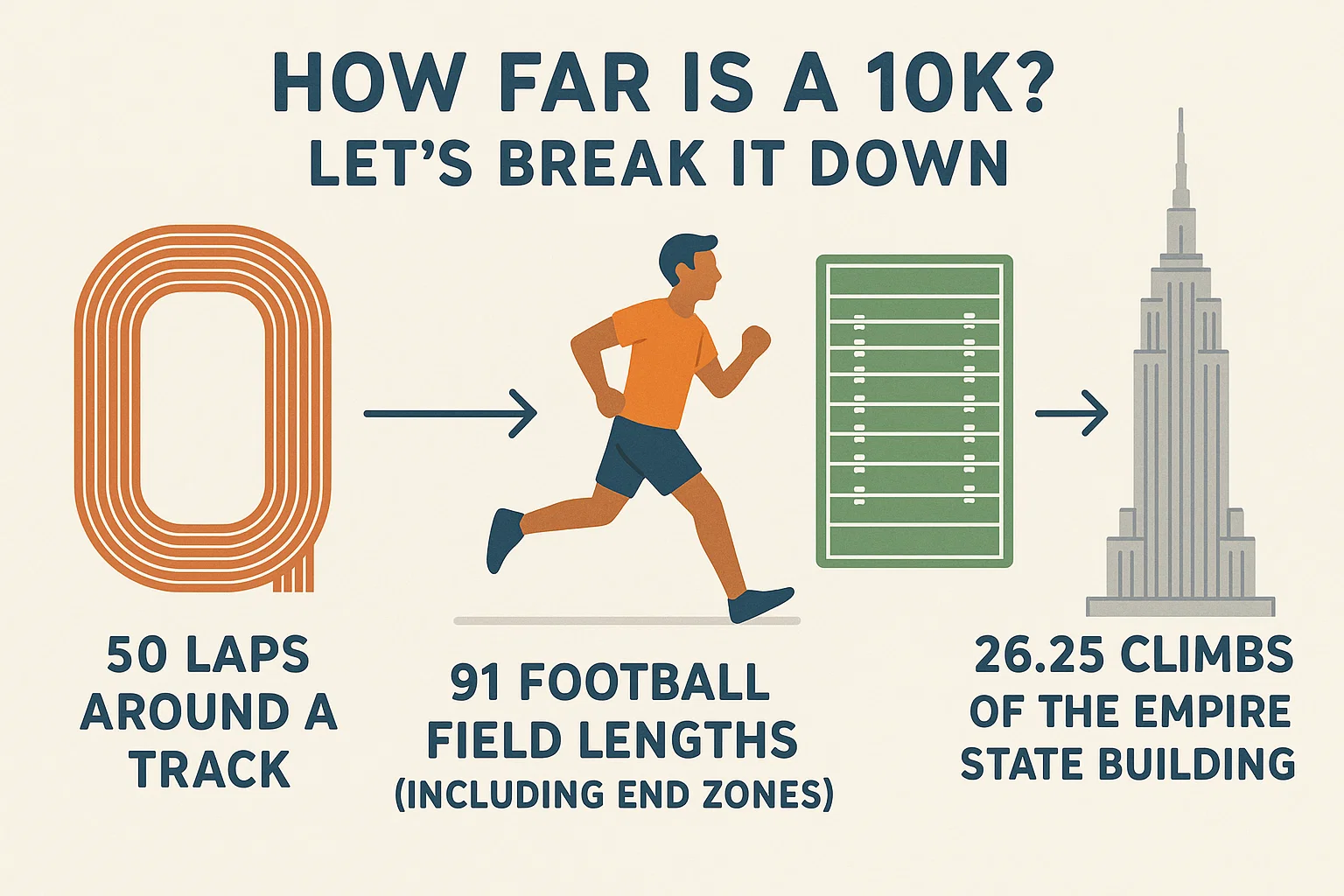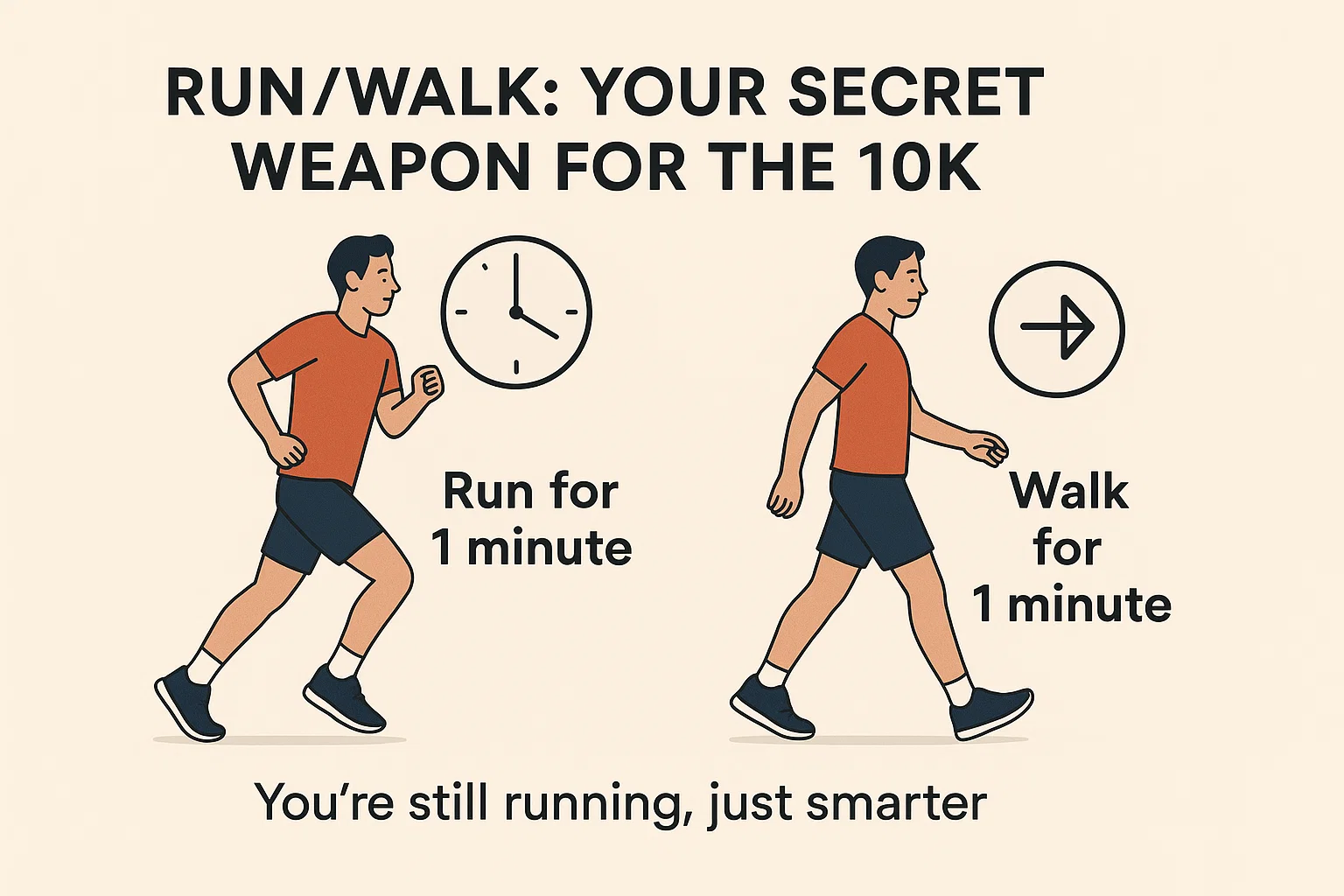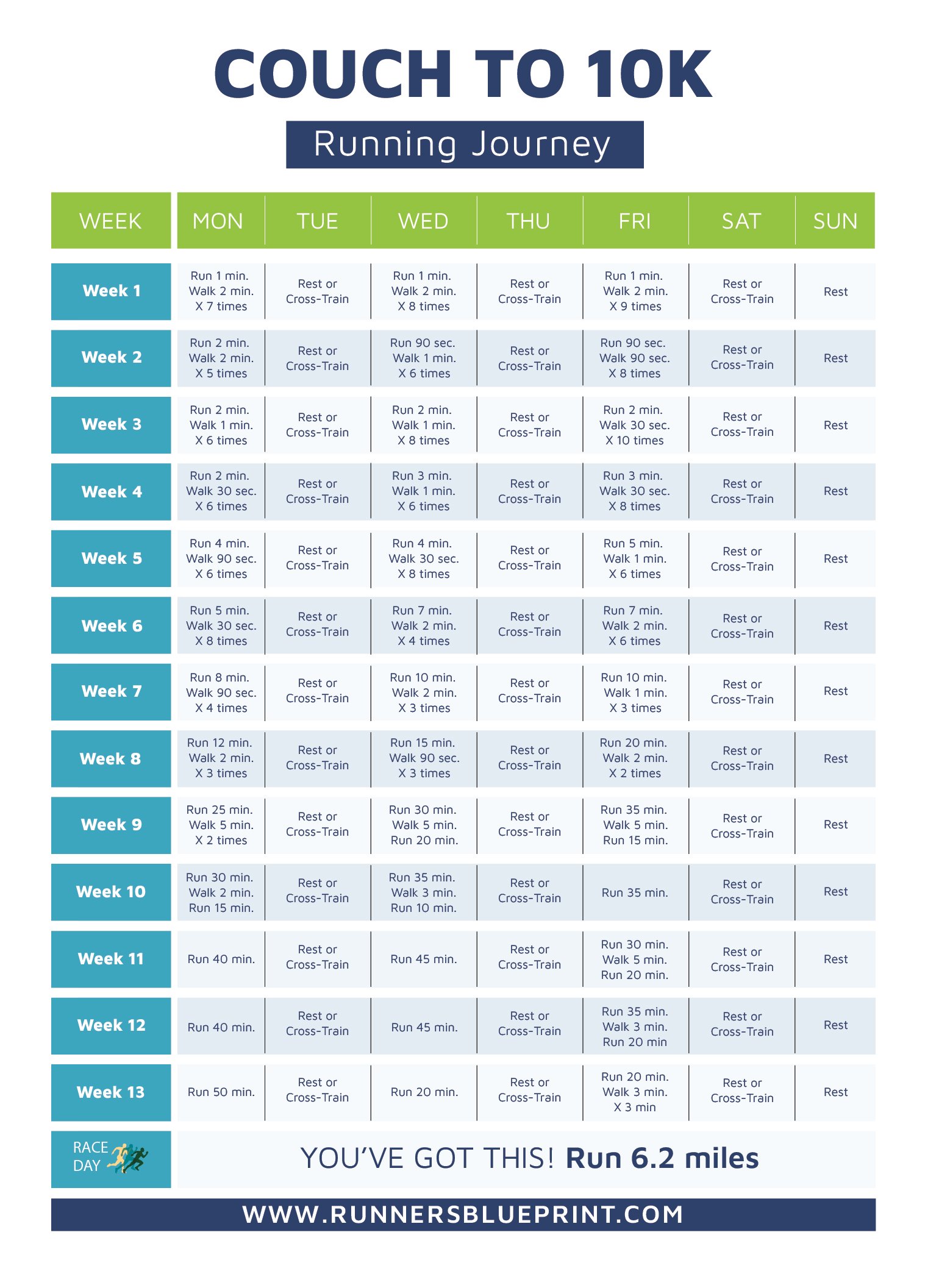You’ve finished your first 5K—nice work! I remember that feeling, crossing the line knowing you’ve just nailed 3.1 miles. It was a big moment, and I couldn’t wait to take on something bigger. Next up?
The 10K. I was nervous, no doubt. How was I going to double that distance? But here’s the deal: you don’t need to change what’s working. Just build on it.
I took my Couch to 5K plan and made it work for a 10K.
And it worked. It’ll work for you, too. Just keep the same steady approach and push a bit further.
You’ve already done the hardest part—getting started. Now, let’s focus on that next 6.2 miles.
Let’s get to it.
Understanding the 10K Distance
Alright, let’s break it down: What’s a 10K? It’s 6.2 miles.
Now, that might sound like a lot at first, but trust me, you’ve got this.
Here’s how I thought about it when I first started:
- Imagine 50 laps around a standard indoor track.
- Or 91 football field lengths (including end zones).
- Or 26.25 climbs of the Empire State Building.
Doesn’t sound so bad, right? Breaking it down like that helped me mentally.
Instead of thinking about 6.2 miles, I’d focus on one lap at a time. That’s what made it feel doable. If you break it up into smaller chunks, the whole thing feels less intimidating.
Who’s Ready for a 10K?
The 10K is a sweet spot. It’s long enough to challenge you, but not so long that it feels impossible. If you’ve been running 5Ks regularly, it’s a perfect next step.
But don’t jump in without building a solid base. If you’re just starting, don’t rush into 10K training right away. I’d recommend that beginners spend a few weeks walking first — up to an hour at a time — before starting any real running.
Now, here’s where you need to listen to your body: if you’re feeling pain or dizziness, stop. You don’t want to push through anything that’s going to set you back. Progress at a pace that feels right.
Trust me, it’s okay to slow down if you’re not feeling it. Listen to what your body’s telling you, and build from there.
Setting Realistic Goals and Pacing
Let’s talk about time goals.
For reference, elite runners finish a 10K in under 30 minutes.
But, for most of us, that’s not the goal. Average time for a guy? Around 55 minutes.
For a woman? Around 1:03. But here’s the secret: this isn’t about being fast. It’s about building your endurance.
If you’re looking to estimate your 10K time, just double your 5K time and add a little bit for fatigue. So, if you run a 5K in 30 minutes, your 10K might be somewhere around 1:03–1:05. It’s not an exact science, but it’ll give you a starting point.
But don’t stress over times — focus on your pace. Instead of asking, “What’s my time?” ask yourself, “How long can I keep running at a steady pace?” That’s the real goal here.
Here’s how your pace impacts your 10K finish time:
The 12-Week Timeline: Why Patience Pays Off
So, why 12 weeks? Seems like a long time, right?
But trust me, it’s the sweet spot for beginners who’ve already got a bit of fitness under their belt (like, you know, walking daily).
Most coaches will tell you that training for a 10K takes a few months. If you’ve been running for a bit, 12 weeks is usually enough to get you race-ready.
If you’re starting from scratch, no worries. Some people recommend doing 6–8 weeks of walk/run first to get your body used to the movements before diving into the real training. Once you’re there, another 12 weeks will do the trick.
The key is to build slowly. Let your muscles, bones, and joints adjust at their own pace. If you rush it, you’re begging for an injury. The rule of thumb?
Increase your mileage by no more than 10–15% each week. Don’t try to push harder every week. Let your body catch up by sticking with the same mileage for a couple of weeks.
Training Intensity: The Talk Test and Heart Rate
Here’s the thing—your runs should NOT feel like a race every time. Most of the time, you should be running at an easy, conversational pace.
Use the talk test:
Can you hold a conversation or sing short bursts? If you’re gasping for air, slow down. If you can’t chat, this isn’t sustainable. So, aim for a level of effort where you’re cruising along at a 5 or 6 out of 10.
Another way to look at it? Heart rate. Try to stay at around 65–75% of your max heart rate. This is Zone 2, or your aerobic zone. It’s an easy jog pace where you could run forever.
Trust me, keeping this pace on your easy days will pay off big time. I was amazed at how my body adapted when I stuck to this zone.
If you push too hard on every run, you’re going to burn out fast. Instead, save the tough sessions (like tempo runs or strides) for specific days. Most of your runs should be easy. Why? They help build a solid aerobic base so you can run further without breaking down.
In practice, I kept my breathing steady and made sure I wasn’t gasping for air. Some days, I’d even run while talking to a friend or listening to a podcast. That kept it chill and fun.
Cross-Training and Strength Work
Look, if all you do is run, you’re missing out.
Cross-training helps reduce the risk of injury—I’ve seen it firsthand. When you mix it up and move in different ways, you strengthen muscles you might not use as much while running.
It helps prevent problems like weak stabilizer muscles or tight hips. That’s just the way it goes. By mixing in different workouts, you’re spreading out the workload and protecting your joints.
But don’t skip strength training. Runners rely heavily on their legs and core, so building strength in key areas is a game-changer. Focus on the glutes, hamstrings, quads, and calves.
I swear by bodyweight exercises like squats, lunges, calf raises, glute bridges, and planks. These moves build the “engine” of my run. After just a few weeks, I could feel a huge difference in my legs and knees.
Even just one good set of strength exercises can change everything. After a couple weeks of squats and lunges, I felt stronger, my knees felt better, and I was faster. If you’re new to strength training, start simple.
Squats and step-ups work your quads and glutes, calf raises hit the calves, and planks build your core and hamstrings. Strength helps prevent injury and keeps you from overtraining, especially as you start adding speed into the mix.
Make sure you’re doing at least two strength or cross-training workouts per week. But don’t go overboard—give your muscles time to recover between workouts. Active recovery counts too, like an easy bike ride or even yoga.
Embracing the Run/Walk Method
If you’re just starting out—or slowly building your mileage—consider the run/walk method. This strategy was popularized by Jeff Galloway back in 1974 when he discovered that adding planned walking breaks helped beginners finish 5Ks and 10Ks without crashing or getting injured.
The coolest part? It worked. His runners finished the race injury-free after just 10 weeks of run/walk training (jeffgalloway.com).
I’ve been there. In my early days, I kept it simple: run for 1 minute, then walk for 1 minute. Repeat. That first month was tough, but it kept me from feeling like I was about to pass out.
If you push yourself too hard, too fast, you’re gonna burn out. Mixing in those walks? It helps your body recover, keeps your heart rate from getting too high, and keeps you from losing focus.
Here’s the deal: you alternate between running and walking in intervals—like 60 seconds running, then 30 seconds walking. It gives your legs a break without stopping altogether.
As time goes on, you’ll gradually extend the run portion—2 minutes running, 1 minute walking, then 3:1, then 4:1. This is interval training for a race—it saves your legs for the long run.
Rest and Recovery: Non-Negotiable
Your training plan needs rest. Period. Rest days are built-in recovery—they’re not a cop-out. I learned this the hard way. I used to skip my rest days, and, no surprise, I ended up burned out or injured.
Rest isn’t a luxury. It’s part of the process. At least one full rest day a week is key. For most beginners, two easy days a week work even better.
Take it easy on those days—do some light stretching or nothing structured. I used to schedule Thursdays and Sundays as my rest days. Even if I felt fine, I stuck to it. No excuses.
Quick Tip: If you’re feeling extra sore, sluggish, or mentally wiped, don’t ignore it. Take an extra day off. Getting to the start line healthy is more important than any single workout.
Your 12-Week Couch-to-10K Training Plan
Here’s a simple 12-week plan. It includes 3 run/walk workouts, 2 cross-training or strength days, and 2 rest days every week. The run/walk days gradually increase your running time, while cross-training keeps your body strong. Modify it based on your schedule, but aim to hit each type of workout.
Week 1 – Getting Started
I’ll never forget my first week of running. I was nervous, doubting myself—but I just kept it slow. For this week, we’re doing run/walk intervals. Try running for 1 minute, then walking for 2 minutes. Repeat that for 6-8 rounds. Total time? About 20-25 minutes.
- Runs (3× this week): Run 1 minute, walk 2 minutes for about 20-25 minutes.
- Cross-training (2× this week): Light cycling, swimming, or yoga. Changing up your cardio will keep you fresh and prevent burnout.
- Rest (2 days): Full rest. Seriously, rest is just as important as running. It’s about recovery and letting your body rebuild stronger.
Mindset: You’re probably asking, “Can I really do this?” I had the same doubts, trust me. But I kept showing up, even when it was tough. It’s all about taking it one run at a time. Before you know it, you’ll see the progress. Keep at it.
Week 2 – Building the Habit
Okay, you made it through Week 1. Now, we’re gonna build on that. This week, we’ll run for 1.5 minutes, then walk for 1.5 minutes. Do that for 6-7 rounds, which will give you about 25-30 minutes total.
- Runs (3× this week): Run 1.5 minutes, walk 1.5 minutes for 25-30 minutes.
- Cross-training (2×): More swimming, cycling, or strength training. Strengthening your legs and core will help you as you increase your mileage.
- Rest (2 days): Full rest. No skipping it.
Mindset: It might feel a bit harder as you up the running time, but that’s part of the deal. The first time I ran 2 minutes straight felt like a huge win. You’ll get there, too. Just keep going one step at a time.
Week 3 – Finding Your Stride
By Week 3, your body is starting to groove with running. It’s like your body is finally getting the rhythm, and you’re feeling stronger. This week, we’ll do 2 minutes of running, followed by 2 minutes of walking for 6-7 rounds, for a total of about 28–30 minutes.
Trust me, you’ll start feeling like you’re picking up steam.
- Runs (3×): 2 minutes running, 2 minutes walking for about 28–30 minutes.
- Cross-training (2×): Keep up with your cross-training but add in some strength work. When I started building up my mileage, strengthening my glutes, hamstrings, and core made a world of difference.
- Rest (2 days): Take two full rest days. If you’re feeling sore, don’t hesitate to take an extra rest day. The goal is to listen to your body and not push too hard, too soon.
Mindset: Here’s the deal: it’s easy to get caught up in comparing yourself to others or worrying about how far you have to go. But listen, you’re doing great! You’re already further along than you realize. Stick to the plan, keep showing up, and celebrate the small wins.
Week 4 – Stepping Up
You’re on the right track! You’ve built a solid foundation, and now we’re stepping it up. This week, try doing a longer run of 8–10 minutes non-stop. For the other runs, do 3-minute runs and 2-minute walks for 25–30 minutes. The key is to get comfortable pushing just a little bit further.
- Runs (3×): One long run of 8–10 minutes, and two shorter runs with 3:2 intervals for around 25–30 minutes.
- Cross-training (2×): Keep strengthening those legs and core. Squats, lunges, planks — all solid stuff to keep your form sharp.
- Rest (2 days): Full rest. Let your body catch up with the increased effort.
Mindset: I remember when I was nervous about running for 10 minutes straight. But here’s the thing — it wasn’t as bad as I thought. You’ll feel the same. Focus on one interval at a time and enjoy watching yourself progress.
Week 5 – Momentum
You’re about to hit that “I can do this!” feeling. This week, let’s aim for a 25–30-minute long run. For the other two runs, try 4-minute runs with a 1-minute walk for about 30 minutes. You’re going to feel more confident and capable.
- Runs (3×): One long run of 25–30 minutes (~3 miles). Two shorter runs with 4:1 intervals for about 30 minutes.
- Cross-training (2×): Keep your cross-training easy but active. Swimming, cycling, or a lighter strength workout will help you stay in shape without overdoing it.
- Rest (2 days): Rest up! If you feel sore, take extra time to recover. It’s better to rest than to risk injury.
Mindset: You’ve been putting in the work, and now it’s showing. You’re making real progress. I remember when running 3 miles felt like a huge challenge, and now here you are, getting closer and closer to your goal. Keep pushing.
Week 6 – Halfway Challenge
You’ve made it halfway — congrats! This week, you’re going to crush your first long run of 4–5 miles (40–50 minutes). Don’t stress if it feels tough; just keep it steady, find a pace you’re comfortable with, and know your body is getting stronger each step.
- Runs (3×): One long run of 4–5 miles (40–50 minutes). Two shorter runs with 5:1 intervals (~30 minutes).
- Cross-training (2×): Keep doing strength work. It’s all about keeping those legs strong as you build your distance.
- Rest (2 days): Full rest. Hydrate, stretch, and get some good sleep to help with recovery.
Mindset: You’ve already put in the work to get here, and this is a big milestone. You’re tougher than you think. Trust me, soon you’ll be looking at a 10K and thinking, “That’s nothing.”
Week 7 – Stepping Toward 10K
You’re getting so close now! Aim for a 5-mile long run (45 minutes) this week. For your other runs, stick with 4:1 or 5:1 intervals for 30 minutes. It’s all about building endurance and confidence.
- Runs (3×): One long run of 5 miles (45 minutes). Two shorter runs with 4:1 or 5:1 intervals (~30 minutes).
- Cross-training (2×): Add in core and leg strengthening to keep your form on point.
- Rest (2 days): Full rest. Focus on recovery and let your body do its thing.
Mindset: I remember when I was feeling a bit nervous about running that 5-mile mark. But once you hit it, you’ll feel like a superhero. Stay positive — you’ve got this. Trust your body.
Week 8 – Final Build-Up
Alright, time to push for your longest run yet: 6 miles (60 minutes). For the other runs, do 5:1 intervals for about 30 minutes. This is your last big training week before you taper, so let’s make it count.
- Runs (3×): One long run of 6 miles (60 minutes). Two shorter runs with 5:1 intervals (~30 minutes).
- Cross-training (2×): Strength and flexibility work — yoga’s a great addition for keeping your body loose and limber.
- Rest (2 days): Full rest. Make sure you’re well-rested and ready for the final push.
Mindset: This week’s a big one. I know it’s intimidating, but remember: you’ve earned this. You’ve been building endurance, and now, it’s time to push your limits. You’ve got what it takes. Let’s crush this.
Week 9 – Taper and Tune-Up
It’s time to scale back a bit and let your body recover. This week, keep your runs easy — just 15–20 minutes — and do light cross-training to stay fresh. You’ve done the work; now it’s time to let your muscles recover for race day.
- Runs (2–3×): Two easy runs (15–20 minutes). One short, steady run (20 minutes).
- Cross-training (1×): Keep it light with swimming or yoga.
- Rest (3×): Full rest.
Mindset: The finish line is so close now. Take it easy this week, and remember: you’ve done all the hard work. It’s normal to feel a mix of nerves and excitement — just enjoy the ride.
Week 10 – Race Week / Celebration
It’s here — race week! Keep your runs light (10–15 minutes) to stay loose, then get ready for race day. You’ve trained hard, and now it’s time to trust that training and take on the challenge.
- Race Day: Start slow. Trust your training and focus on your pace. When you cross that finish line, take a moment to soak it all in — you’ve earned it.
Weekly Breakdown:
You’ve got all your runs, cross-training, and rest days laid out for you. Stick to the plan, adjust as needed, and keep showing up. This is how you build the strength and endurance to crush that 10K.
Congratulations!
By Week 12, you’ll have built the endurance to rock that 10K! Keep showing up, stay focused, and keep pushing yourself. You’ve got this!
Here are some useful links on the history of the 10K and some interesting facts.
- 10K Wikipedia Page.
- Things you need to know before your first 10K race.
- 10K racing tips.
- The PRRO official website.
- The IAAF 10K page.
- How to run a 10K in one hour
Note – If this 10K plan is too much for you, try my couch to 8K schedule instead.
FAQ: Couch to 10K Training
Q1: How long does it take to go from couch to 10K?
Most Couch to 10K programs take 8 to 12 weeks, depending on your starting fitness and consistency.
Q2: Does Couch to 10K really work?
Yes—Couch to 10K plans are designed to build endurance gradually, helping beginners run a 10K safely and confidently.
Q3: How many days a week should I train?
Most plans recommend 3 to 4 days of running per week, with rest or cross-training days in between.
Q4: What if I miss a day or can’t finish a workout?
It’s okay—just pick up where you left off or repeat the missed workout before moving on. The key is to stay consistent and patient with your progress.
Q5: Can I walk part of the 10K?
Absolutely! Walking breaks are common, especially for beginners, and they help you manage your energy.
Q6: Should I add strength training to my Couch to 10K plan?
Yes—strength training helps prevent injuries and improves overall running performance.
Q7: Do I need special shoes for Couch to 10K?
Invest in a pair of comfortable, supportive running shoes that fit well to reduce the risk of injury.
Q8: How fast should I run during training?
Run at a conversational pace, where you can talk without gasping. Speed comes naturally as fitness improves.
Q9: What if I feel pain while running?
Stop and assess—mild soreness is normal, but sharp pain might indicate an injury. When in doubt, rest and consult a professional.




